Vector Analysis Methods
Querying and overlaying vector layers, key operations and techniques.
Vector Analysis Methods
Many operations can be done with vector data.
- Some methods are very similar.
- Distinctions between methods can be subtle, but important.
- Can complete the same tasks, but need slight changes to a workflow.
- Typically in GIS there are multiple ways to get the same answers.
- Some “routes” are just more direct.
Querying Attributes
Finding features of interest based on attributes.
- A good way to reduce data volumes, export queries to new layers
- In ArcGIS Pro you can Select by Attribute
- Uses SQL (Structured Query Language)
- Check equality, relative magnitude, etc.
- Combined with operators: AND / OR
Querying Attributes
Finding features of interest based on attributes.
- If we’re only interested in historic residential buildings:
- Where “YEAR BUILT” ≤ 1950 AND
“TYPE” = “Residential” - Save as a new layer, won’t have to search through all the objects every time.
- Where “YEAR BUILT” ≤ 1950 AND
Select by Attribute
Sample SQL queries
- Where “SPECIES” = “Pine”
- Where “SPECIES” ≠ “Pine”
- Where “HEIGHT” ≤ 5
- Where “SPECIES” = “Pine” AND “HEIGHT” ≤ 5
- Where “SPECIES” = “Pine” fc0314OR “HEIGHT” ≤ 5
| Species | Age | Height |
| Pine | 10 | 5 |
| Pine | 95 | 28 |
| Oak | 200 | 25 |
| Oak | 5 | 4 |
Select by Attribute
Sample SQL queries
- Where “SPECIES” = “Pine”
- Where “SPECIES” ≠ “Pine”
- Where “HEIGHT” ≤ 5
- Where “SPECIES” = “Pine” AND “HEIGHT” ≤ 5
- Where “SPECIES” = “Pine” OR “HEIGHT” ≤ 5
| Species | Age | Height |
| Pine | 10 | 5 |
| Pine | 95 | 28 |
| Oak | 200 | 25 |
| Oak | 5 | 4 |
Select by Attribute
Sample SQL queries
- Where “SPECIES” = “Pine”
- Where “SPECIES” ≠ “Pine”
- Where “HEIGHT” ≤ 5
- Where “SPECIES” = “Pine” AND “HEIGHT” ≤ 5
- Where “SPECIES” = “Pine” OR “HEIGHT” ≤ 5
| Species | Age | Height |
| Pine | 10 | 5 |
| Pine | 95 | 28 |
| Oak | 200 | 25 |
| Oak | 5 | 4 |
Select by Attribute
Sample SQL queries
- Where “SPECIES” = “Pine”
- Where “SPECIES” ≠ “Pine”
- Where “HEIGHT” ≤ 5
- Where “SPECIES” = “Pine” AND “HEIGHT” ≤ 5
- Where “SPECIES” = “Pine” OR “HEIGHT” ≤ 5
| Species | Age | Height |
| Pine | 10 | 5 |
| Pine | 95 | 28 |
| Oak | 200 | 25 |
| Oak | 5 | 4 |
Select by Attribute
Sample SQL queries
- Where “SPECIES” = “Pine”
- Where “SPECIES” ≠ “Pine”
- Where “HEIGHT” ≤ 5
- Where “SPECIES” = “Pine” AND “HEIGHT” ≤ 5
- Where “SPECIES” = “Pine” OR “HEIGHT” ≤ 5
| Species | Age | Height |
| Pine | 10 | 5 |
| Pine | 95 | 28 |
| Oak | 200 | 25 |
| Oak | 5 | 4 |
TopHat Question 1
How many rows in this table would the following query return?
Where “SPECIES” = “Pine” AND “SPECIES” = “Oak”
| Species | Age | Height |
| Pine | 10 | 5 |
| Pine | 95 | 28 |
| Oak | 200 | 25 |
| Oak | 5 | 4 |
| Birch | 5 | 4 |
TopHat Question 2
How many rows in this table would the following query return?
Where “SPECIES” = “Pine” OR “SPECIES” = “Oak”
| Species | Age | Height |
| Pine | 10 | 5 |
| Pine | 95 | 28 |
| Oak | 200 | 25 |
| Oak | 5 | 4 |
| Birch | 5 | 4 |
Proximity Analysis
Looking at spatial relationships within or between layers.
- A good way to reduce data volumes, export queries to new layers.
- Multiple options, depending on our needs.
- If we’re only interested in buildings within 1 km of streams:
- Identify by proximity
- Save as a new layer, won’t have to search through all the objects every time.
Select by Location
Use to check for spatial relationships such as:
- Containment
- Intersection
- Distance
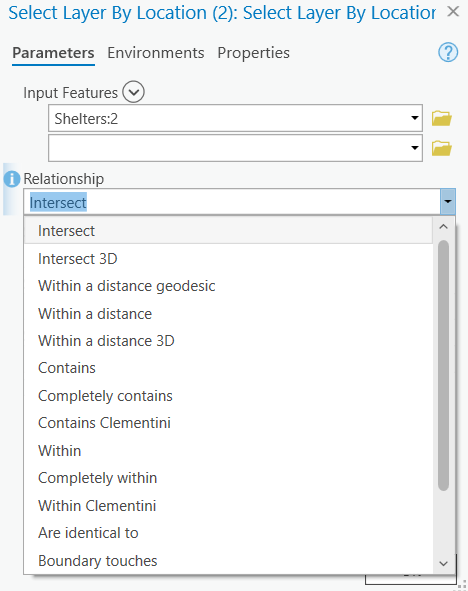
Geometric Manipulations
These methods create new layers with altered “geometries”. Geometry is a term we use to refer to points, lines, and/or polygons in a vector layer.
Buffer
Create a new Polygon layer based on distance.
- Buffer points, lines, or polygons using a buffer distance or set a field to specify varriable distance.
- Use the Multiple Ring Buffer tool for multi-criteria buffers.
Example From ESRI Docs
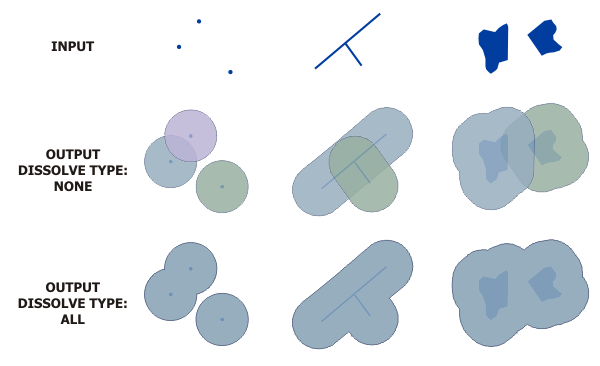
Buffer
Create a new Polygon layer based on distance.
- Buffer points, lines, or polygons using a buffer distance or set a field to specify varriable distance.
- Use the Multiple Ring Buffer tool for multi-criteria buffers.
Buffering Tsunami Shelters

Dissolve
Aggregates features.
- Merges objects completely or by attribute(s).
- Can calculate statistics for aggregated regions.
- Useful if our data is more “complex” than we need it to be.
Example From ESRI Docs
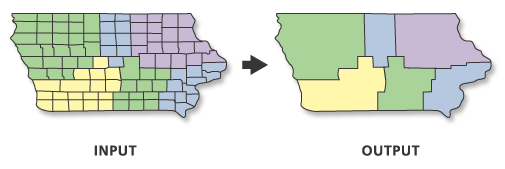
Dissolve
Aggregates features.
- Merges objects completely or by attribute(s).
- Can calculate statistics for aggregated regions.
- Useful if our data is more “complex” than we need it to be.
Dissolve Shelter Buffers
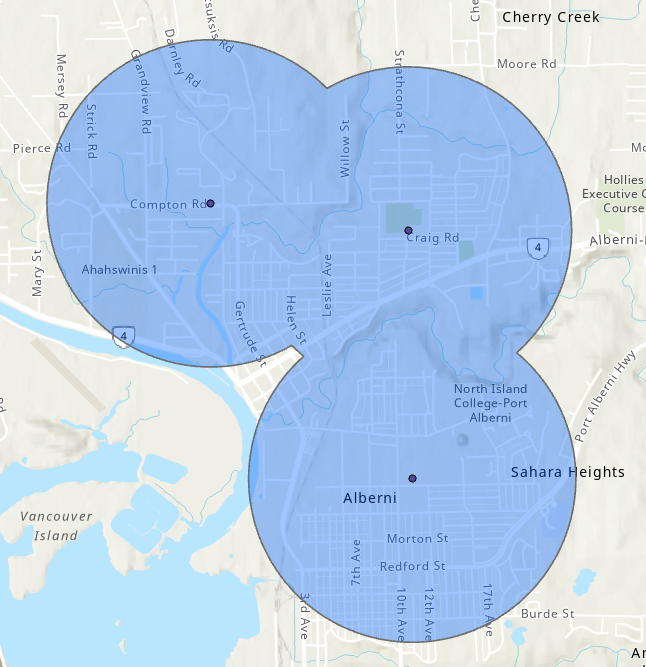
TopHat Question 3
This tool allows us to aggregate vector objects in a layer, either completely or by specific attribute values.
- Buffer
- Dissolve
- Select by Attribute
- Merge
Feature Overlay
When we have multiple data layers and we want to combine them to form a new output.
Clip
Cut one layer down to the boundaries of another.
- Useful when we want to focus on a study area
- Does not alter attributes
- Input layer: our data layer
- Clip layer: the study area
Example From ESRI Docs
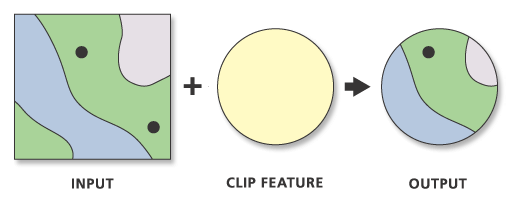
Clip
Cut one layer down to the boundaries of another.
- Useful when we want to focus on a study area
- Does not alter attributes
- Input layer: our data layer
- Clip layer: the study area
Input
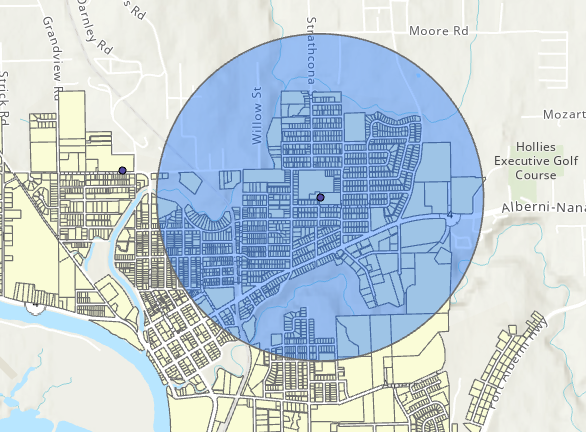
Clip
Cut one layer down to the boundaries of another.
- Useful when we want to focus on a study area
- Does not alter attributes
- Input layer: our data layer
- Clip layer: the study area
Output
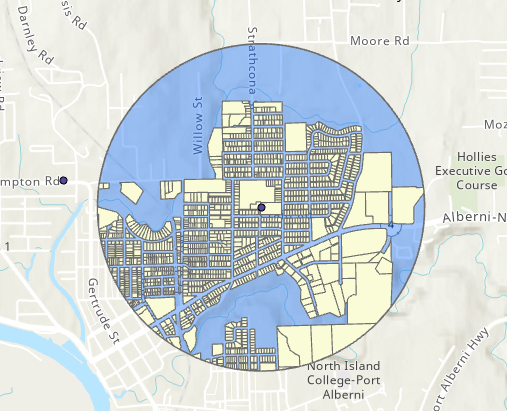
Erase
Remove the area of one layer from another.
- Opposite of the clip tool
- Does not alter attributes
- Useful when we want to discard/exclude an area
Example From ESRI Docs

Erase
Remove the area of one layer from another.
- Opposite of the clip tool
- Does not alter attributes
- Useful when we want to discard/exclude an area
Input

Erase
Remove the area of one layer from another.
- Opposite of the clip tool
- Does not alter attributes
- Useful when we want to discard/exclude an area
Output

Intersect
Output where layers overlap and combine attributes.
- Can handle more than two layers at once
- Splits features by overlaps and merges attribute tables
- Merge and parse data at the same time
Example From ESRI Docs
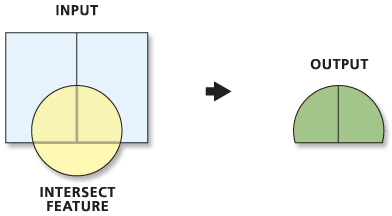
Intersect
Output where layers overlap and combine attributes.
- Can handle more than two layers at once
- Splits features by overlaps and merges attribute tables
- Merge and parse data at the same time
Input

Intersect
Output where layers overlap and combine attributes.
- Can handle more than two layers at once
- Splits features by overlaps and merges attribute tables
- Merge and parse data at the same time
Output

Union
Combine multiple polygon layers, split features where they overlap and combine attributes.
- Similar to intersect, but keeps overlapping areas
- Adds attributes from all overlaps.
- Can handle more than two layers at once.
- Null values where for new attributes where no overlaps are present.
Union
Combine multiple polygon layers, split features where they overlap and combine attributes.
- Similar to intersect, but keeps overlapping areas
![]()
Many More
There are many more vector overlay tools! I have presented some of the the most frequently used tools, but if you have specific use cases you may need others. I can’t cover them all, and I don’t want to overwhelm folks.
TopHat Question 4
Clip and erase remove portions of layer based on location relative to another layer but they do not alter the attribute table.
- True
- False
